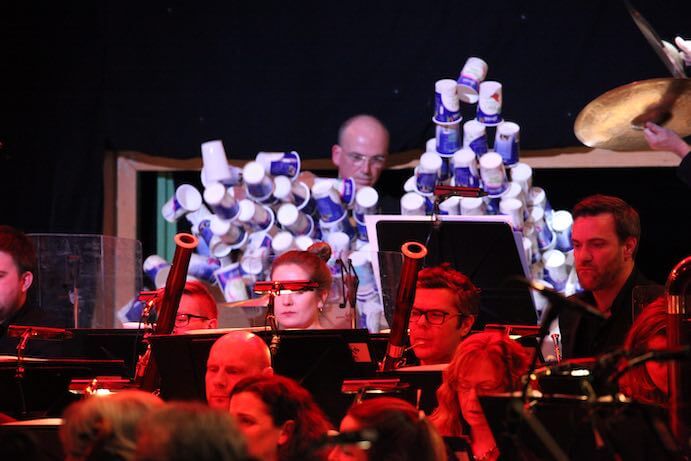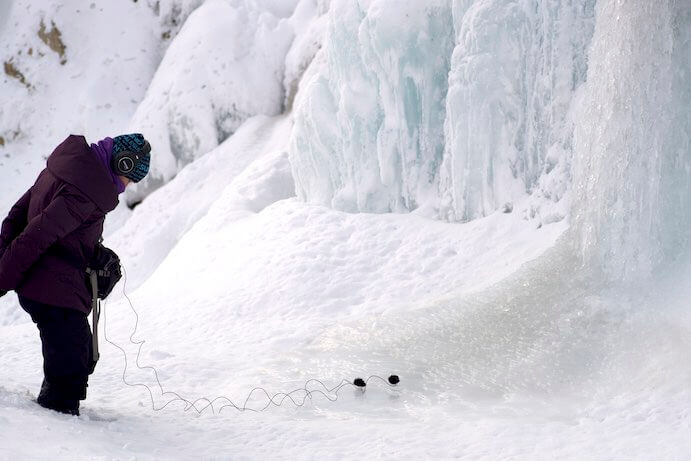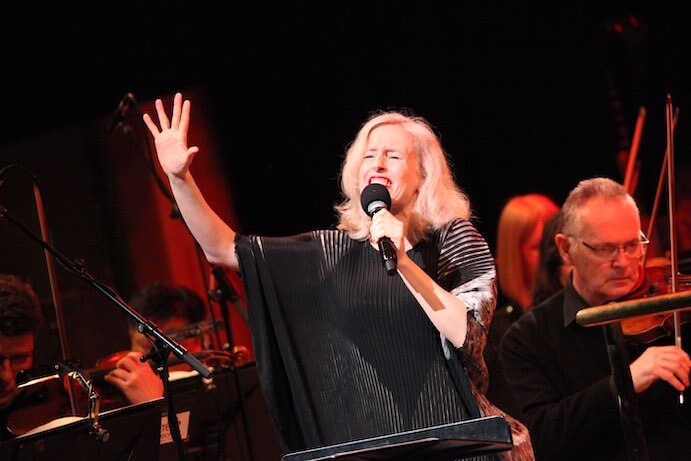I’ve had the privilege of spending the last six months living and studying experimental sound practice in Cork, Ireland, participating in the music community, and meeting as many creative artists as possible. Many times, when asked where I’m from originally (Pittsburgh), I qualify my answer by saying something like, “yeah, so, the size of the state I grew up in is actually about the same size as the entire island of Ireland.” This, of course, seems preposterous; Ireland is a country where you can gig around the entire island in a week or so, and maintain close connections with artists from Dublin to Killarney, Cork to Belfast, without ever being more than a five-hour bus trip away.
The new music scene is, thus, very active and interconnected, and came together to celebrate this at New Music Dublin 2019 (Feb. 28-March 3). In some ways, it was the same as other new music festivals; however, as director John Harris noted in his welcoming remarks, “there is something exciting happening in Irish New Music,” and this festival celebrated that in full. There’s a critical mass of work by composers from Ireland making waves beyond the confines of the island—Jennifer Walshe and Ann Cleare are building huge international careers (Cleare was recently named recipient of the Ernst von Siemens prize), Donnacha Dennehy and the Dublin-based Crash Ensemble have become common names within the American scene, as have young composers including Amanda Feery, Finola Merivale, and Emma O’Halloran (who were instrumental in the beginnings of the #HearAllComposers campaign of 2017). But the fact remains that this is just the tip of the iceberg: contemporary music of all strokes is alive and well in Ireland, and New Music Dublin made every effort to proudly share this work.
The event kicked off with a grand operation: the premiere of two pieces for orchestra by Irish composers Jennifer Walshe and David Fennessy, performed by the RTÉ National Symphony Orchestra under the direction of Jean Deroyer. Walshe’s The Site of an Investigation is a roaring examination of the age of the internet, with Walshe’s stylized vocals leading the orchestra through sound masses, bass-driven electronica beats, and ponderous chorales. In some ways, this material kaleidoscope was everything you expect of Walshe’s style—what set this piece apart was that, rather than leave the audience to build associative meaning, Walshe very clearly set before us the observation that there is something fundamentally broken about how technology has warped our understanding of life and humanity. It was thematically chaotic and musically gripping, but The Site of an Investigation was also profoundly sad, a lament for how we’ve come to value the simulacrum of people over the person themselves. Given that the piece was dedicated to Walshe’s friend Stephen Swift, who died in 2018 after a battle with cancer, the work was incredibly moving.

Jennifer Walshe’s The Site of an Investigation at New Music Dublin–Photo by Joanne Taaffe
This was followed by Fennessy’s Conquest of the Useless, a grand fantasy retelling of Werner Herzog’s film Fitzcarraldo. Fennessy had a clear vision for the work; snatches of Rigoletto fight with clicking bug sounds, Fennessy’s guitar melts into itself amidst Caruso’s swirling voice, a mezzo-soprano blossoms above the orchestra, all composed as a hazy dreamscape. Unfortunately, the piece did not hold together despite the clarity of conviction. Moments were often too long or out of place, and there was an obliqueness to the orchestration and narrative that robbed the piece of its potentially dream-like state. Had sections been significantly condensed or re-ordered, Fennessy would have more successfully created this fractured reality.
Nevertheless, this opening concert set the tone for New Music Dublin: commitment to the presentation of the vibrant Irish contemporary music scene.
The next day started, for me, with a visit to Sounds Like Art, three sound installations by Irish sound artists and composers. Danny McCarthy’s The Threshold of Quiet featured hundreds of small bells calmly set on the ground with their clappers removed— a striking image, and a beautiful instigation for reflection. In the next room was Jürgen Simpson’s Quartet for Four Parallel Planes, a sculpture of translucent blocks with affixed LED lights, coordinated with the octaphonic speaker array. The result was a mesmerizing display, visual patterns folding in and out of themselves in parallel with the flickering soundscape. Lastly was Karen Power’s location, location, location, an eight-channel array of field recordings particularly focused on isolated spaces. The cracking of ice or chirping of birds gave way to brief bustles of human voice mixed with unidentifiable sounds, creating a space that exists somewhere but that lies beyond grasp. This was supplemented with photography by John Godfrey and occasional improvised performances by Dublin-based vocal ensemble Tonnta.

Sound artist Karen Power recording a frozen waterfall–Photo by John Godfrey
One of my few complaints about New Music Dublin was the comparative lack of attention given to these installations, Tonnta’s drop-in performances, and the ongoing short films commissioned by Crash Ensemble as responses to Crash’s 2017 release, Ghosts. While I am definitely biased as a student of two of the installation artists, I’ve found the sound art/improvisation scene an especially vibrant part of the Irish contemporary music landscape. Devising a more publicized central event to present this kind of work would only add to future iterations of the festival.
I then moved across the hall to the Fidelio Trio’s concert of piano trios by Ann Cleare, Linda Catlin Smith, and Kevin Volans. While all three pieces were performed with an unquestioned technical virtuosity, the character of each work was not always on full display. The textures and gestures of Cleare’s 93 million miles away mean to evoke a duality of distance, locations simultaneously close and wholly unreachable. Though Fidelio knows this piece intimately (they commissioned it in 2016), I couldn’t sense the space suggested by the material, exacerbated by the jolting smack of page turns. Smith’s Far From Shore is, in contrast, a droning work that asks for a more meditative treatment than Fidelio’s precision gave, though the unity of gesture created by cellist Adi Tal and violinist Darragh Morgan was stunning. Volan’s Piano Trio no. 3: Le Tombeau des Regrets was the least effective of the three, a colorful work that made extensive use of repetition and abrupt change. This manipulation of time failed to evoke timelessness or a shifting relationship with the material, instead sounding undynamic and random, despite the distinct sense of ensemble Fidelio achieved.
The audience then scurried down to the National Gallery for Entente Cordiale, a collaboration between students and faculty of the Royal Irish Academy of Music and the Paris Conservatoire presenting work by Irish composer Amanda Feery, as well as Boulez, Andriessen, and Saariaho. The performances were brilliant, a testament to these two institutions in promoting 20th- and 21st-century music among their students. The only problem was the hall; situated in a beautiful foyer in the Gallery, the excessive reverb affected the performances. Boulez’s Dérive I was shrouded rather than glistening, Andriessen’s Hout smeared from an intricate study in “composed reverb” to a cloud shifting up and down in frequency. Alternatively, the reverb augmented Feery’s Blood Under Winter-White Skin, a piano trio balancing continuous lines with flickering ornaments of color that merged beautifully in the Gallery. Saariaho’s characteristic textures were similarly enhanced by the space in Changing Light, though the work itself was not as engaging as other of her works.

Entente Cordiale at New Music Dublin–Photo by Joanne Taaffe
My time at New Music Dublin ended with back-to-back grand performances: the RTÉ Concert Orchestra under Robert Houlihan giving the Irish premieres of Saariaho’s Graal théâtre and Andriessen’s Vermeer Pictures; and Crash Ensemble’s first performance of the weekend, giving the Irish premiere of Fausto Romitelli’s Professor Bad Trip: Lessons 1, 2 and 3. Solo violinist Hae Sun Kang deftly wove through the Saariaho, though the orchestra failed to rise through the gossamer textures to capitalize on potentially dramatic moments. The Andriessen was utterly captivating, the characteristic block orchestration sculpting out a sound world that managed to maintain a heightened energy within a static, patient forward motion.
Romitelli’s Professor Bad Trip was, simply, hard not to love. Crash performed with incredible energy and ferocity under the guidance of conductor Richard Baker, painting a sonic palette of tactile drones with such gravity that filigree snatches of color were subsumed back into the haze. The work is almost absurdly difficult for its aural homogeneity, but this tension between specificity and the resultant soundscape gives the work its infamous sense of unreal, inescapable chaos, which Crash delivered as a brilliant end to the day.
Sadly, at this point, I left New Music Dublin, but the music-making only ramped up. The following days included Crash’s Free State 11, featuring the premieres of six works by emerging Irish composers; reportedly-astonishing choral concerts by Chamber Choir Ireland, RTÉ Cór na nÓg, and RTÉ Cór Linn; and Ensemble Musikfabrik playing Zappa, among many other performances. There were also sessions for young composers and performers to interact with professionals and learn about getting “On the Radar,” and the welcome presence of the inaugural group of NMDX International Delegates: new music festival artistic directors, ensemble directors, concert series promoters broadcasters, publishers and administrators invited to experience and share in the celebration of Irish New Music. Everybody in Ireland knows of the vibrant contemporary music community—New Music Dublin was a chance to show this off, and curated some phenomenal sounds and conversations along the way.





















